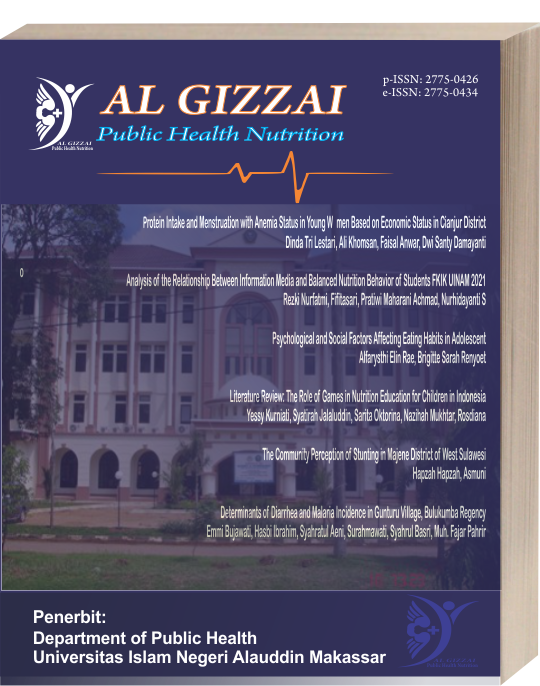Protein Intake and Menstruation with Anemia Status in Young Women Based on Economic Status in Cianjur District
Abstract
Anemia is a micronutrient problems worldwide, especially in developing countries. According to WHO in 2015 the prevalence of anemia in adolescent girls to date ranges from 40-88%. In Indonesia, the prevalence of anemia based on the 2018 Riskesdas is 32% in the 15-24 year age group, with a higher proportion of anemia in women than men. This study aims to determine differences in protein intake and menstruation with anemia status of adolescent girls based on economic status.
This research is a quantitative research with an observational analytic approach and a cross sectional design. This research was conducted in Cianjur Regency, West Java Province in November 2019-January 2020. The selection of adolescent subjects was taken based on schools participating in the weekly iron-folate supplementation program from the Cianjur District Health Office which was carried out by purposive sampling with a minimum sample of 56 young women . Data were collected through interviews using a questionnaire. Examination of blood hemoglobin levels was carried out by health laboratory workers in Cianjur Regency using a 301 hemocue.
The results showed that there were no differences in hemoglobin levels, duration of menstruation and menstrual cycles in the low and low economic groups high . Then there is no relationship between the length of menstruation and the menstrual cycle with the anemia status of the subject. Furthermore, there are difference intake protein in both groups. Also, there is a relationship between protein intake and anemia status in subjects.
References
Adnan HA, Desa A, Sulaiman WS, Ahmad MI, Mokhtar DM. (2014). Emotional intelligence and religious orientation among secondary school students. Jurnal Psikology Malaysia. 28(2): 1-17.
Andriza. 2018. Pengaruh lama menstruasi dan status gizi terhadap kejadian anemia pada remaja putri di Nahdatul Ulama Palembang tahun 2017. Masker Medika. 5:372-380.
[BPS] Badan Pusat Statistik. (2020). Perencanan Pembangunan. Jakarta.
Dittner AJ, Wessely SC, Brown RG. (2004). The assessment of fatigue practical
Fatimah. (2012). Anemia dalam Gizi dan Kesehatan Masyarakat. Jakarta: PT Raja Grafindo Persada.
Fayet-Moore F, Kim J, Sritharan N, Petocz P. (2016). Impact of breakfast skipping and breakfast choice on the nutrient intake and body mass index of Australian children. Nutrients. 8: 487-499.
Febrianti, Utomo WB, Adriana. (2013). Lama Haid dan Kejadian Anemia pada Remaja Putri. Jurnal Kesehatan Reproduksi. 4(1): 11-15.
Fiqriyah R, Hari W, Ro’ufah I. (2016). Pengaruh pengelolaan uang saku, modernitas, kecerdasan emosional, dan pemahaman dasar ekonomi terhadap rasionalitas perilaku konsumsi siswa kelas X IIS MAN 1 Malang. JPE. 9(1).
Guyton AC, Hall JE. (2007). Buku Ajar Fisiologi Kedokteran. Jakarta: EGC.
Hadijah S, Hasnawati, Hafid MP. (2019). Pengaruh masa menstruasi terhadap kadar hemoglobin dan morfologi eritrosit. Jurnal Media Analisis Kesehatan.
Hardinsyah, Hadi R, Victor N. (2014). Kecukupan energi, protein, lemak, dan karbohidrat. Jakarta (ID) : Widyakarya Nasional Pangan dan Gizi X.
Jalambo MO, Hamad A, Abed Y. (2013). Anemia and risk factors among female secondary studentsin the Gaza Strip. Journal Public Health. 21:271–278.
Kaur K. (2014). Anaemia ‘a silent killer’ among women in India. Euro J Zool Res: Present scenario.
Kolodzjieg S and Lato K. (2015). The Role of Parental influences on the economic socialization of children. University Warsaw, Poland. Problems of education in the 21stcentury. 8 (99)
[Kemenkes] Kementerian Kesehatan Repulik Indonesia. (2018). Riset Kesehatan Dasar (Riskesdas). Jakarta (ID): Kemenkes RI.
Patofisiologi konsep klinis proses-proses penyakit. Jakarta: EGC;p. 231-2.
Proverawati. (2010). Anemia dan anemia kehamilan. Yogyakarta: Nuha Medika.
Syatriani S, Aryani A. (2010). Konsumsi Makanan dan Kejadian Anemia pada Siswi Salah Satu SMP di Kota Makassar. Jurnal Kesehatan Masyarakat Nasional, 4(6).
Thalib SB. (2010). Psikologi Pendidikan Berbasis Analisis Empiris Aplikatif. Jakarta : Kencana Prenada Media Group.
Teji K, Yadeta D, Tesfaye A, Meyrema A. (2016). Anaemia and nutritional status of adolescent girls in Babile District, Eastern Ethiopia. Pan African Medical Journal. 24 (1).
Utami NH, Rosha BC. (2013). Anemia dan anemia gizi besi pada kehamilan: hubungannya dengan asupan protein dan zat gizi mikro. Jurnal Ekologi Kesehatan. 12:224-33.
Utami, Baiq Nurlaili, dkk (2015). Hubungan Pola Makan dan Pola Menstruasi dengan Kejadian Anemia Remaja Putri. Jurnal Keperawatan Soedirman. The Soedirman Journal of Nursing. 10(2).
[WHO] World Health Organization. (2015). The Global Prevalence Of Anaemia In 2011. Geneva: World Health Organization.
Yunarsih. (2014). Hubungan Pola Menstruasi Dengan Kejadian Anemia Pada Remaja Putri Kelas VII SMP N 6 Kediri. Jurnal ilmu Kesehatan. 3(1): 25-33. doi: https://doi.org/10.32831/jik.v3i1.42.
Copyright (c) 2022 Dinda Tri Lestari

This work is licensed under a Creative Commons Attribution-NonCommercial-ShareAlike 4.0 International License.
Authors retain copyright and grant the journal right of first publication with the work simultaneously licensed under a Creative Commons Attribution-NonCommercial-ShareAlike 4.0 International License that allows others to share the work with an acknowledgment of the work's authorship and initial publication in this journal.
Authors are able to enter into separate, additional contractual arrangements for the non-exclusive distribution of the journal's published version of the work (e.g., post it to an institutional repository or publish it in a book), with an acknowledgement of its initial publication in this journal.
Authors are permitted to publish their work online in third parties as it can lead to wider dissemination of the work.










